With the market being flooded with Red Dot Optics it’s hard to know which ones are actually decent anymore. We set out to try and find the best red dot sights on the market to help make your job a bit easier.
So what makes a good red rot optic? Well, for starters durability plays a huge factor when looking for something that you might potentially depend your life on at some point. At first glance, durability seems pretty straight forward but when it comes to optics, there are a lot of measured factors. The first measure of durability for any rifle/pistol sight is the housing. You’re pretty much guaranteed that any red dot optic or reflex sight that isn’t made from a metal body will have a shorter shelf life than one made from aluminum. The second piece of durability comes in the actual waterproofing of the housing unit. Many of the cheaper red dot optics will come with a slight weather sealing but will accumulate moisture in the rain or wet conditions. Conversely, some of the top of the line red dot sights are designed to be submersible for naval operations and waterborne infiltration. Another piece of durability comes in the overall quality of the glass used in the optic itself. It’s safe to say that not all glass is created equal and in many cases, the biggest driver of an optic’s cost comes from the quality of glass used. Good glass is considered scratch-resistant, crisp with low distortion meaning the image you see through the lens is true to what you would see in real life. Finally, you want to ensure the red dot inside the optic won’t move in the event of extreme weather change. This is a hot topic at the moment due to some companies in the past who had that issue causing people to lose their zero if the weather went from one extreme to another.
Next to durability comes cost. The bottom line is that any red dot scope, reflex sight, holographic sight, or whatever else you want to call it will be priced pretty much according to their quality. If an optic is priced ridiculously cheap, it’s probably because it’s pretty garbage. However, most optics that come in at a higher price point tend to offer better quality. In short, with this product line, you do tend to get what you pay for.
So what are the different terms you should know?
Red Dot Optics tend to be a fairly large and broad category. So let’s break down what a few of the key terms mean.
Reflex Sight vs Prism Sight vs Holographic Sight
A red dot sight is not an actual sight, it just refers to an optic that uses a red dot as an aiming point. There are several types of red dot sights to include a reflex sight, a prism sight, and a holographic sight.
What is a Reflex sight?
A reflex sight is an optic that uses a lens that functions as a mirror. Basically, a red dot (in the form of an LED) is projected onto a semi reflecting lens that you can see through. The biggest advantage of a reflex sight is that the point of aim of the red dot will not move as you move your eye’s location making it parallax free. In other optics, if you move your head/eye side to side you can actually change the aiming point of the optic. In a flex sight, the red dot shows the point of impact of the round (obviously not accounting for bullet drop). This makes reflex sights an excellent CQB optic. Reflex sights can be battery-powered or powered by light through a tritium tube. Another advantage of the optic is that very little power is required to show the red dot so the optic’s batteries can last a lot longer than other types of red dot sights.
What is a Prism Sight?
Prism sights are a red dot optic contained in a tube that uses a prism to show the image you’re looking at. Prism sights are often used with a slight magnification (usually up to 3 x power). Prism sights are great for both CQB and mid-range engagements, however, in order to properly acquire a proper sight picture you need to have a closer eye relief than say a reflex sight. In general, prism sights are more expensive than reflex sights but they are becoming more popular thus causing a more competitive price point.
What is a Holographic Sight?
A holographic sight is a sight that features a holographic image between two lenses. Chances are you are most familiar with Eotech holographic sights, probably because Eotech has the patent on holographic sights so they are the only ones making them. The biggest advantage of a holographic sight is like a reflex sight the sight picture doesn’t change based on the location of your head. In general, holographic sights are very precise and accurate. However, they do tend to be a lot more expensive. In addition, Eotech had a few issues over the years with the quality of their sights and reporting those issues to their end-users.
Reflex Sight Vs Red Dot Sight
As mentioned, a reflex sight is pretty much a red dot sight. A red dot sight can be a reflex sight in the sense that the reflex sight uses a red dot as an aiming point. All the reflex sights we recommend in this article feature a red dot as an aiming point. It’s important to point out that with all of this terminology there are lots of grey areas and people tend to get wrapped up in the specifics. But don’t worry, by the end you should have a decent idea of what a reflex sight offers and what to look for if you want to pick one up.
First focal plane vs second plane
In this red dot review, we also take a look at low variable powered optics that have a red dot aiming point. You could argue that these aren’t technically red dot optics but we figured we’d include them since they are starting to replace red dot sights in a lot of different areas. In any optic with two focal planes, the reticle will be placed on either the first focal plane (FFP) or second focal plane (SFP). The biggest difference between the two is how the reticle appears to the user as you zoom in or out. With a first focal plane reticle, the reticle will change in size as you zoom in or out. On a second focal plane, the reticle stays the same size no matter how the optic is zoomed in or out. AmericanHunter.org offers an excellent article on the difference between FFP vs SFP along with the image below.
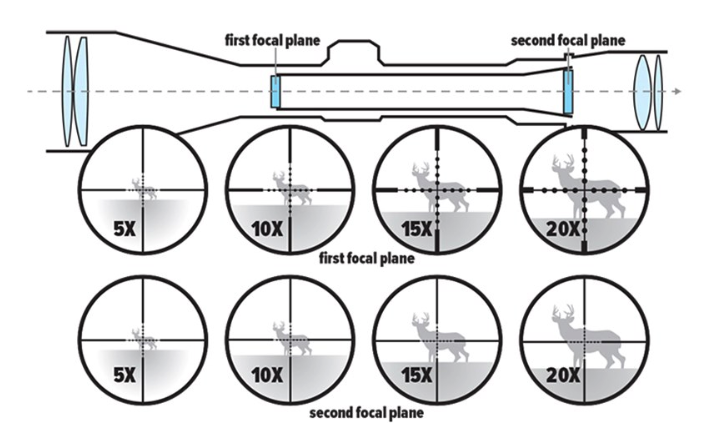
In general, SFP has been popular among hunters and more traditional rifle scopes while FFP optics are becoming increasingly more popular with long-range shooters and snipers. The biggest reason FFP is becoming more popular for long-range shooters is the fact that FFP is better for accuracy when calculating shots. More specifically, your hold over and hold unders are going to remain the same no matter what the magnification setting of the optic while an SFP is only accurate for a holdover/under at one magnification. In short, if you’re looking to get a red dot optic for long-range shooting you will most likely want an FFP optic.
Now that we have a good idea of the particulars of a red dot optic, let’s take a look at our 2019 buyers guide of the best red dot optics.
Best Red Dot Sight
Here we are reviewing Red Dot Sights that offer no magnification. These have been traditionally used by SWAT and military units operating within close quarters like cities. These offer the user the ability to quickly engage close targets because you don’t need to have a specific eye relief or head placement. These optics are typically lighter and less expensive than a variable powered red dot sight. In addition, they tend to have less moving parts making them less prone to have mechanical issues.
Disadvantages of Red Dot Sights
Because these optics have no magnification they are not ideal for mid to long-range engagements. As such, many units are moving away from these types of sights for use on standard service rifles because it keeps personnel from having the upper hand in longer-range engagements. If you’re looking for a basic optic to take to the range that won’t break the bank, this is probably your best bet. But if you’re looking for something more versatile consider a variable power red dot optic.
Our Top Rated Red Dot Sights
Aimpoint Micro T2– $730+ (Price increases with options)
The Aimpoint T2 is a long-standing champion when it comes to red dot sights. They’ve spent the past 10 years perfecting the sight to be a durable, accurate, and reasonably priced product. The T2 is arguably the most common red dot optic used by Special Operations and police SWAT alike.
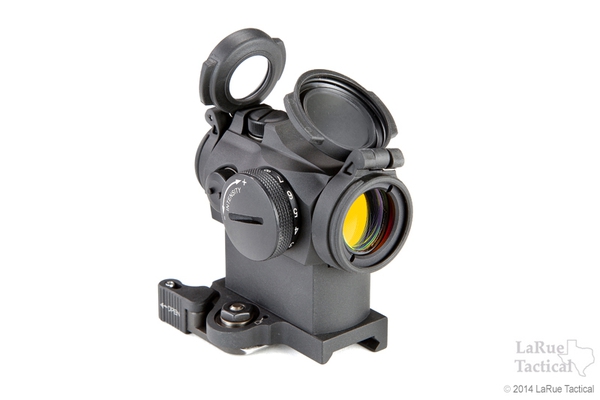 AimPoint T2 Features:
AimPoint T2 Features:
The Aimpoint T2 features an enhanced light-absorbing glass making it easier to use in low light conditions. The optic includes a rear flip up cap that you can actually see through allowing you some added lens protection if needed. The T2 is also one of the lightest optics on the market weighing in at just 3.7oz. However, probably the best feature of the T2 is its zero parallax glass that allows you to not have to worry about eye relief when using the optic. The T2 is also a great optic to use if you’re looking for something to use with night vision or in low light conditions. Aimpoint created the T2 Micro to have 4 NVG settings and 8 daytime settings allowing you to have a wide variety of options for any condition. The Aimpoint is also highly water-resistant and can be submerged to depths up to 80 feet, making it a preferred optic of many naval/marine units.
Why you would buy the AimPoint T2 Micro
You should consider purchasing the T2 if you are looking for an extremely rugged optic that can be used for CQB, waterborne operations/heavy weather, with NVGs or in low light conditions.
Why you shouldn’t buy the AimPoint T2
If budget is a major factor in your decision you should consider something else. This optic is designed and used for intense military operations and might not be ideal for hunting, basic marksmanship or in-home protection. As such, the T2 is priced a lot higher than its competitors. The T2 starts at around $730 and can cost upwards of $970 for additional mounting solutions and colors.
Editorial note- We have personally run the Aimpoint T2 on our rifles in combat operations since 2009. It’s an extremely well tested and well trusted optic. It is not ideal if you are looking for something with magnification, however, if you purchase this optic you can be rest assured you are purchasing something that is of the highest quality on the market.
2. Leupold LCO- $910
The Leupold LCO is a newer contender to the red dot market but is making big waves. This red dot sight offers some incredible features that is getting the attention of SOCOM and a number of other well respected units and police departments.
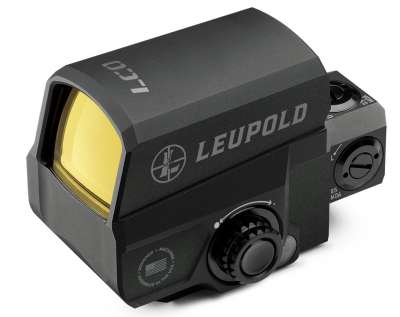
Leupold LCO Features:
Leupold did an excellent job creating an optic with an incredibly large viewing area that isn’t also bulk or heavy. They opted to place the dial settings on the back of the optic, rather than on the side. This allows the optic to have a slim housing and a much larger viewing area… pretty genius. They also include 16 red dot power settings allowing the user to see the red dot in all situations, to include NVGs. We had a chance to use the LCO when it first came out and we were very impressed. Our guess is this red dot optic will be a big contender moving forward.
Why You Should Buy The Leupold LCO
If you’re looking for something that offers a wide viewing area for CQB operations, consider the LCO. Leupold has been building high quality scopes for years and they know what they are doing when it comes to making optics.
Why You Shouldn’t Buy the Leupold LCO
Like the Aimpoint, the LCO is not cheap. At $900+ it’s one of the more expensive red dot sights you can buy, but you will be getting what you pay for.
3. Crimson Trace CTS-1000 – $299
Crimson Trace was brand new to the optics game in 2018 and we recently had a chance to get a first look. CT did a great job of putting together an optic at a very competitive price point. We are excited to see where these go in 2019. We want to make this recommendation with the notion that this sight still has a lot of field testing needed, however it’s off to a great start.
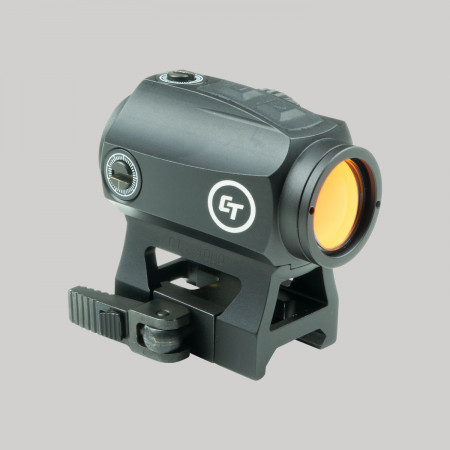
CTS 1000 Features:
The Crimson Trace CTS 1000 is a simple yet reliable design. The optic comes with a 2.0 MOA red dot housed in a sturdy aluminum housing. CT did a great job of making the red dot require a minimal amount of energy and the battery only needs to be recharged every 9 years. If that doesn’t impress you the fact that CT will replace all your batteries for free, for life, should. In addition, the CTS 1000 is built out of a durable aluminum housing with a robust water-resistant design that ensures your sight can withstand wet conditions.
Why You Should Buy the Crimson Trace CTS 1000
This is a great sight to look at if you are on a tight budget. It comes in at a very affordable price and for what you get it’s actually a great deal.
Why You Shouldn’t Buy the Crimson Trace CTS 1000
The CTS 1000 is a brand new optic and as such, it’s going to have some kinks. Crimson Trace did a great job designing the optic but now they need some time to test it out. Still, given the price point, you will have a hard time finding a better ratio of quality to cost on the market.
Best Variable Power Red Dot Sight
Ok, so before you go to the comment section and tell us a variable power scope isn’t technically a red dot sight let us say, yeah we know. This section covers a list of variable power scopes that also happen to have a red dot as part of the aiming system. We are including these because there are some excellent variable power scopes that could act as a replacement for a traditional red dot optic. A variable powered red dot sight is any sight that offers a variable zoom, that has a red dot aiming feature.
You will want to use a variable powered optic if you believe you might be using the optic in a wide variety of environments. A variable power zoom allows you to engage in close quarters battle situations as well as mid-length engagements. Most variable power optics for ARs and CQB will have a zoom range 1 – 5 with some going up to 1-8. Many units are switching to variable power optics to operate in environments like Afghanistan where users engage in CQB as well as longer open engagements. Because this type of optic is becoming so popular there are some great new options hitting the market. These mini rifle scopes are becoming lighter, shorter, and offering levels of optical clarity that’s never been produced before.
Disadvantages of using a variable power red dot sight
While there are some great advantages to using a variable power sight there are some key disadvantages as well. First, variable power optics are more complex and consequently are more expensive. In addition, they are longer than traditional reflex sights so if you are operating a shorter rifle with limited real estate the scope could become an issue. Variable power scopes are also traditionally heavier (although they are becoming lighter) so if you’re concerned about weight this might not be the best option for you. Finally, a variable powered scope can be difficult to acquire quickly, which is very important during fast, close up engagements like CQB.
Our Top Rated Variable Powered Red Dot Sights
1. Sig Sauer Tango6 1-6 x 24mm– $1,199
Let’s be honest, Sig’s optics up to this point haven’t been the best, however, this year they upped their optics quality… by a lot. So much so that the US Army announced that they had awarded Sig with a contract to outfit the Designated Marksman program with the Tango 6 and they aren’t the only ones choosing the Tango 6 as a duty optic.

Tango 6 Features:
The Tango 6 1 -6 is a variable powered optic with a 24mm objective lens. One of Sig’s key features in the Tango6 is the HDX Optics extra-low dispersion glass which allows for incredible optical clarity, especially in low light situations. They also coat the lenses in LensArmor abrasion-resistant film to help keep the optic from scratching. One of the other key features is the optic’s Lockdown Zero System which ensures the user can rapidly return to zero and that the turret will stop at zero without moving past, something that is a common issue in other optics on the market. One of the other cool features of the Tango 6 is the MOTAC (Motion Activated Illumination) which powers up when it senses motion and powers down during times of inactivity, allowing an increased battery life.
Why You Should Buy The Tango 6
If you’re looking for a durable variable powered optic with incredible lens quality and all the bells and whistles.
Why You Shouldn’t Buy The Tango 6
If price is a variable this might not be the optic for you. In addition, the optic can be submerged up to 1 meter but if you think you want to use for any sort of naval/marine operations it might not hold up.
2. Night Force NX8 1-8 x 24mm F1– $1715
Night Force is a longtime contender in the optics market and has recently started making a bit of a comeback. The NX8 is rapidly becoming a favorite for many units and is being looked at for use in several military contracts.

Night Force NX8 Features:
The Night Force NX8 has some impressive features, most notably an overall length of 8.75″ while weighing in at only 17 ounces. This makes the NX8 an excellent optics for AR-15 style SBRs. The NX8 utilizes a first focal plane which is coupled with an 8 powered zoom making it more suitable for long range engagements than some of the competitors on the market. We are also fans of NF’s proprietary reticles that are designed to give the user rapid engagement capabilities along with the ability to dial in more precise shots if needed.
Why You Should Buy the NX8
If space and weight are an issue, consider the NX8.
Why You Shouldn’t Buy the NX8
The NX8 does use a proprietary reticle that may not jive with your sighting techniques. If you have specific training on engaging using a different type of reticle this one could be tough to get used to.
3. Steiner Optics M5Xi- $2200
Steiner Optics has been making optics since the early 1900s and they have some of the best glass around. They are one of the only companies that actually make their own glass. That paired with German engineering makes Steiner an incredibly elite optics company. 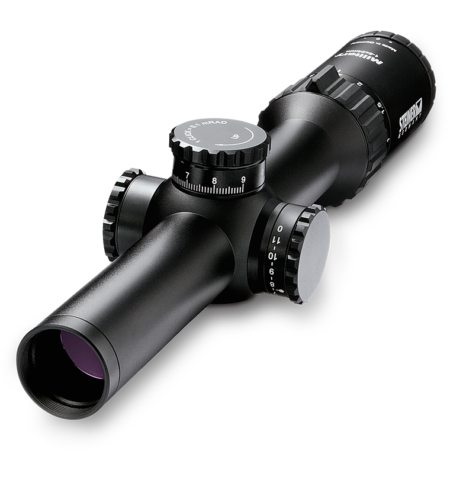
Steiner M5Xi Features:
The Steiner M5Xi is a great option for any duty rifle due to its compact and lightweight design. The optic features a true 1 power setting meaning that when the optic is used at a 1 power or lowest zoom it accurately depicts what you’re looking at. Several other variable power optics often have a slight distortion even when set to a 1 power setting. Steiner’s M5Xi is part of Steiner’s M series which is specifically built to meet and exceed all military standards. The M5Xi is no exception to quality and it’s about as durable as they come. Steiner is also well known for their optic’s low light gathering capabilities so this is a great option for anyone wanting to use it during night operations.
Why You Should Buy The Steiner M5Xi
If money is of no concern, consider the M5Xi. This thing is built like a tank and has some of the most amazing glass you can find. It also comes with Steiner’s award-winning customer service.
Why You Shouldn’t Buy the Steiner M5Xi
If you’re not going to use it for military/duty operations this scope might be a little too good. It’s built to the highest standards but it’s also priced accordingly and is one of the most expensive optics we could recommend.
The Best RMR Sights
RMRs sights are becoming increasingly more popular among both shooting enthusiasts, police, and military personnel for use on pistols. An RMR sight is essentially a reflex sight that mounts on a pistol and acts as a rapid aiming device. In short, these are pistol red dot sights.
Advantages of an RMR Sight
Using an RMR sight can help you acquire your target quickly and accurately. After some training, you will most likely find it a lot easier to find than a traditional pistol sight. The bright red dot is easy to find in the bright daylight and especially helps people with vision issues or if they have a hard time focusing on the front sight post.
Disadvantages of an RMR Sight
First and foremost, RMRs are not cheap. A good RMR will run you around $400+ and the costs can go up from there if you have to change your holster for the updated optic. In addition, RMRs can be hard to use if you haven’t trained on them. You should not use an RMR as a duty optic until you’ve spent plenty of time at the range. Finally, RMRs require a battery that can go out over time. If your battery goes out while on a mission there’s no backup sight available.
Our Top Rated RMR Sights:
1. Trijicon RMR RMO6 Type 2– $699
While RMRs are fairly new to the market, Trijicon probably has the most experience making them. They also have some incredible quality and recently won a SOCOM solicitation.
![]()
Trijicon RMO6 Features:
The Trijicon RMO6 comes with a dependable electronic design with an adjustable LED. Their battery conservation mode ensures a long battery life and a less likely chance that the optic will go out when you need it the most. The optic also comes with easy use windage/elevation adjustments which is a common issue in other types of RMRs. The RMR is naturally parallax-free which is extremely important when being used on a pistol. Finally, it’s waterproof up to 20 meters and features a very strong housing that ensures it can withstand any element you throw at it.
Why you should buy the Trijicon RMR RMO6
If you want the best RMR that money can buy, this is it. This is a durable, long-lasting optic that has been tested and approved by SOCOM for use in the field.
Why you shouldn’t buy the Trijicon RMR RMO6
If money is an issue, this isn’t the optic for you. You can get less robust versions of the optic for around $400 but it’s still a lot more expensive than other options on the market.
2. Leupold DeltaPoint (DP) Pro- $519
The Leupold DP Pro is a very close second to the Trijicon RMO6 in just about every way. Leupold is newer to the RMR market but put a lot of time and effort into ensuring the DP Pro offers top of the line quality.
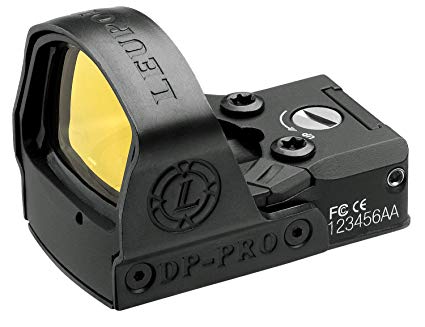
Leupold DP Pro Features:
The DP Pro comes with some awesome features such as their proprietary MST (Motion Sensor Technology) that automatically turns off the optic after 5 min of inactivity and turns it back on as soon as movement is detected. The DP features a 7.5 MOA red dot with over 120 MOA of windage and elevation travel adjustment which ensures you will be able to dial it to zero no matter what platform you place it on. Once dialed in you can lock your adjustments to ensure the optic doesn’t wander during use. If you have the cash to spend, this is an awesome option as an RMR.
Why You Should Buy The Leupold DP Pro RMR
Like the Aimpoint, you should consider this optic if you have the money to spend and if you’re after extreme quality. Leupold’s over-engineering of this optic will ensure it can withstand the elements and any other abuse you throw at it.
Why You Shouldn’t Buy the Leupold DP Pro RMR
Again, if budget is an issue, maybe look elsewhere.
3. Vortex Viper RMR- $329
The Vortex Viper is about as inexpensive as you can get with an RMR while still maintaining quality. Because RMRs take a ton of abuse, you won’t be able to get away with a really low-end optic. The Viper is produced overseas to help keep the costs down but as such, they are not able to be procured for government use.

Vortex Viper Features:
The Vortex Viper comes with 6 MOA red dot housed in a durable housing. We like the easy touch illumination buttons on the side that help control the optic’s brightness levels. Like the Leupold DP there’s 120 MOA of elevation/windage travel to ensure you can get your sight dialed to zero.
Why You Should Buy the Vortex Viper RMR
If you’re looking for something that is of decent quality and won’t break the bank, this is your optic.
Why You Shouldn’t Buy the Vortex Viper RMR
If you’re a government customer you won’t be able to buy this optic since it’s not Trade Act Compliant.
So What’s The Best Red Dot Sight For The Money?
This is a tough one to answer. As mentioned there are a ton of different options on the market and the term red dot sight encompasses a lot of different optics. At the end of the day, you will first want to identify the kind of optic you need and then start looking at which of the optics above are going to best fit your needs. So here are a few options to look at based on different budgets.
Under $500- Vortex Red Dot Sight
The Vortex Crossfire is an option if you’re really trying to keep your budget down. Vortex has really upped their game in the past few years and is making some pretty nice optics. For $219 you’re not going to get a super high-quality optic, but if you’re going for something low budget this is a good option.
Under $1000- AimPoint T2
We’d say the Aimpoint T2 is probably your best option under $1000. It has a long-standing history of success and a very safe bet.
Under $2000- Steiner or Vortex
If you’re willing to spend some cash, look at getting either the Vortex Razor, $1999, or the Steiner M5Xi. Both of these are incredible optics that won’t let you down.







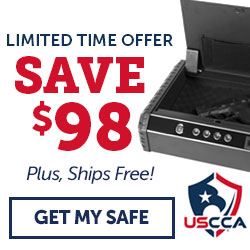
Leave a Reply
Your email address will not be published. Required fields are marked *